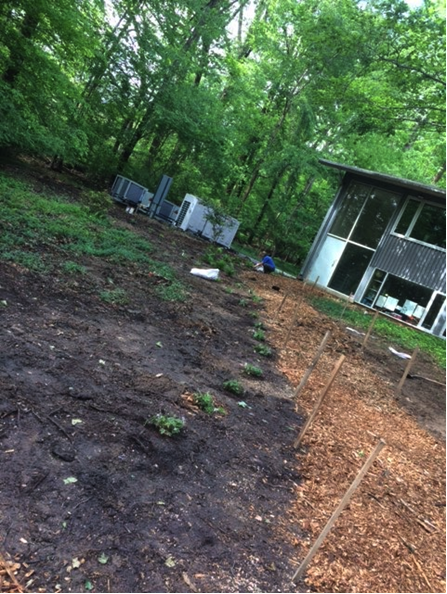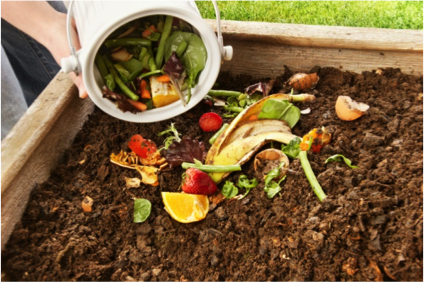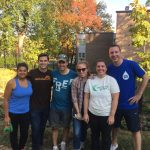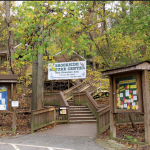Native Plant Conservation Project
Emily Isaac, B-CC High School
On May 5th, I implemented one of the largest-scale projects I have ever planned: a conservation planting at the Cedar Lane Unitarian Universalist Church, covering an area of about 50×25 feet. From an outside view, it might look like the project’s purpose was simply to beautify the area outside the church, but there is much more behind it than that. The area where I performed the planting had been recently disturbed due to the addition of a new HVAC system, which left the area dry, packed, and devoid of plant life. I wanted to take this opportunity to take a blank slate and make into something new.
All of the plants that I introduced into the area are native, first and foremost. Native plants are important not only because they are in danger of being overrun by invasives, but because they are best suited to serve the ecosystem of the area they appear in. These native plants will create a safe space for bees, birds, and native animals alike. The addition of plants to the area will also prevent extreme erosion and runoff, which the previously packed area was in danger of.
Last but not least, the implementation of these native plants will provide an important educational opportunity for the kids in the nursery school that resides within the church. Environmental education is not nearly common enough in school systems, and the best way for kids to start good habits about taking care of their environment is to introduce these ideas at a young age. A hands-on, outdoor educational unit focusing on native plants and the environment will help these kids become environmentally focused for the rest of their lives.
It takes an idea, motivation, and hard work for a project like this to become a reality and to leave a significant impact on the community. I hope that my project will not only make the area nicer to look at but will inspire others to do what they can for the environment and the people around them.


Walt Whitman Composts
Nick Mole, Walt Whitman High School
In today’s consumer-oriented society, there are so many products right at our fingertips, and it’s easy to get caught up in buying the newest, hottest items and overlook how much we’re throwing away. And this is a problem. Not only because American trash production has tripled in the last 50 years, but also landfills produce a large amount of methane, a “potent greenhouse gas” with 21 times the global warming potential of carbon dioxide1. And the most significant contributor to this landfill methane production? Food waste. Just like new iPhones, clothes, and various appliances, people have a large variety of food options, and for many Americans, food is relatively accessible.
As a result, people take their food for granted and throw much of it away. For my Leadership Academy project, I want to combat the negative environmental effects of food waste, leave a lasting impact on the culture and practices of my community, and hopefully inspire others to make small lifestyle changes to help the environment.
With these goals in mind, I decided that the best way to accomplish my goals would be to bring composting to my school, Walt Whitman High School in Bethesda. With the help of local company Compost Crew, which is run by alumni of Whitman, along with Bethesda Green and my school, full-scale composting during lunch will hopefully begin next school year. Funding still needs to be secured for the Compost Crew collection service and the necessary bins, but after funding is acquired and materials set up, my project will be ready to be implemented. Additionally, a waste audit will be carried out, involving sorting through the school’s trash to collect data on the volume of food waste currently being thrown away. This will provide metrics which can be used to predict how much compost will be produced, as well as provide a baseline to help measure the success of the composting program in the future. Whitman will also have to opportunity to undertake a pilot program with smaller scale composting at the beginning of the 2017-2018 school year.
Being the first school in the area to compost on a full scale, Whitman will be a leading example for other schools to follow. More and more cities, offices, and schools are adopting environmental practices such as composting each year. This trend is an indicator of a larger culture shift happening in the world, one that is positive, and spreading environmental advocacy and sustainability. Hopefully, as a society, we can come together and embrace this change, and look forward to a cleaner, healthier future.
Works Cited
1: https://www3.epa.gov/region9/waste/features/foodtoenergy/food-waste.html


Walter Johnson Leads By Example Project
Noora Youssefi, Walter Johnson High School (WJ)
When given an objective to create a project involving my community with a focus on sustainability, I could only think of the place that is used every day by 2,300 students and has an unnecessarily large environmental footprint – my high school. I had to do something that would make my school a more sustainable facility. Being involved in WJ’s Environmental Club, I had the chance to meet with DJ Connelly, the School Energy and Recycling Team (SERT) Manager, Montgomery County Public Schools (MCPS). During one meeting with Mr. Connelly, he told the club about the Lead By Example contest, a competition where students from different MCPS schools create a conservation plan that includes multiple initiatives to work towards a sustainable future for their school. I applied to the contest for my Leadership Academy project.
The first step was to set sustainable goals for the school. WJ did not have a recent energy audit, so we did not have a starting point to set the goals. Mr. Connelly provided WJ with multiple tools, such as a watt calculator and a light meter, to complete an updated audit. I used a watt calculator to measure the energy usage of everyday tools used such as a pencil sharpener and a computer charger. Once the basic energy audit was complete, I set goals WJ could achieve shortly such as lowering the energy usage and getting students more involved in keeping WJ an environmentally friendly school. I used a light meter to check if any classrooms were over-lit causing unnecessary energy usage, in efforts to lower WJ’s energy usage.
During a WJ Earth Day event, students came to learn about what they can do, such as making sure all faucets are fully closed and recycling the correct materials and placing them in the right bins. After all, efforts were complete, photos and summaries of the events were placed in a presentation and set off to SERT for review. A couple of weeks later, news came in that WJ did not place in the Lead By Example contest. Not placing in the contest was disappointing but the goal of making WJ a more sustainable school was achieved. Students and staff became informed on what they could do to continue making WJ more sustainable, which was the overall objective. WJ will apply for the contest again next year now that students and staff have a better idea of what to do.





